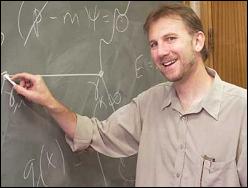University physicist on world particle team
Friday, September 11, 2008
University physicist
on world particle team
 Professor of physics Tony Signal is on the
international team working to replicate the “big bang”
that created the Universe.
Professor of physics Tony Signal is on the
international team working to replicate the “big bang”
that created the Universe.
Professor Signal says he’s been involved with some of the design of the experiment, which will use the world’s most powerful particle accelerator, the new Large Hadron Collider, to collide two beams of protons.
“Hopefully we’ll see all sorts of new things,” he says. “Obviously the number one thing people are looking for is the Higgs particle which is responsible for the masses of all the other particles. The way we think about mass is really to say how strongly other particles interact with the Higgs, some interaction is very weak and they are not affected while some have very strong interaction. This is really important because it explains the mass of everything and is the last piece of the jigsaw missing in the standard model of physics.”
Professor Signal, who is chairman of the New Zealand group collaborating with the project, says another area of interest is the mysterious “dark matter”.
“What everybody is really hoping is to see something new and unexpected. This could be hopefully be an explanation of dark matter – there’s much more in the universe than what we can see. The dark matter is something we can’t explain using normal physics.”
The organisation running the collider project is known as CERN, using the French acronym for the European Organisation for Nuclear Research. It has built a 27-kilometre tunnel at its facility on the Swiss-French border. The proton beams have been tested in a clockwise direction, and will now be tested anti-clockwise, with the two beams fired into each other later this year.
“The beams are less than the width of a hair,” Professor Signal says. “They have to enter the tunnel and be precisely aimed to hit each other. When they collide there’s lots of energy and that’s when we hope to see new particles or phenomena coming out. The energy densities we are looking at are really comparable [to the big bang] but the size is very, very much smaller.”
The New Zealand team was involved in the design of the experiment including part of the central detector, near the collision point. They have also worked on ensuring the beams enter the experimental apparatus correctly so they can collide at the centre.
Professor Signal says he is closely monitoring his computer from the Palmerston North campus to watch the experiment unfold. “Being part of the experiment we have full access to all the data it will churn out and will try and do some analysis of that in New Zealand using our computers connected to the grid.”
He says he hopes to have completed some analysis by the end of the year.
ENDS


 Business Canterbury: Urges Council To Cut Costs, Not Ambition For City
Business Canterbury: Urges Council To Cut Costs, Not Ambition For City Wellington Airport: On Track For Net Zero Emissions By 2028
Wellington Airport: On Track For Net Zero Emissions By 2028 Landcare Research: ANZAC Gall Fly Release Promises Natural Solution To Weed Threat
Landcare Research: ANZAC Gall Fly Release Promises Natural Solution To Weed Threat NZ Anti-Vivisection Society: Auckland Rat Lovers Unite!
NZ Anti-Vivisection Society: Auckland Rat Lovers Unite! University of Canterbury: $1.35 Million Grant To Study Lion-like Jumping Spiders
University of Canterbury: $1.35 Million Grant To Study Lion-like Jumping Spiders Federated Farmers: Government Ends War On Farming
Federated Farmers: Government Ends War On Farming



